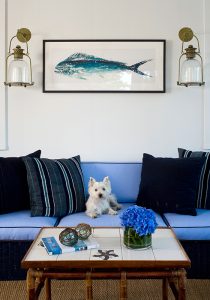
Photo source: Pinimg https://bit.ly/2pIgSht
Don’t let renting a house stand in the way of your design aspirations. With a pinch of imagination, you can transform your rented home, tackling even the most overlooked areas such as the hallway or landing.
Try these landlord-friendly ideas for adding personality and character to your home.
Light it up
Lighting is an easy, high impact way to brighten up your home. An eye-catching floor lamp can change the whole feel of a room, so use it to highlight your style. And the best part? You can take it with you when you leave.
Treat your feet
Whether you’ve got wooden floorboards, laminate or carpet, you’ll need to protect it to protect your deposit. Rugs and runners are typically inexpensive and will enhance and style a room or hallway whilst keeping the floor intact.
Accessorize
Inject life into your home with bold prints and jazzy patterns. Textured scatter cushions and chunky throws will add personality to any room with minimal effort or cost.
‘Mirror-mirror!’
A mirror is a classic addition to any room, but there’s no need to fix it to your wall.
Where your tenancy agreement doesn’t allow you to drill holes to hang a mirror, try propping it against the wall instead.
This will add the illusion of space and depth and using a large mirror in a cramped hallway or smaller bedroom will make it look twice as big.
Add artwork
Just as with mirrors, making holes in the walls to display photos and artwork may not be possible in a rental home. Use what you have to avoid causing any damage to the walls; a fireplace mantle, existing shelving or a freestanding cabinet.
Try framing a large piece of art or a poster and leaning it against a wall to make a stylish statement.
Make it modular
When you potentially move every 1-2 years, you want furniture which you can take anywhere. Modular furniture is perfect for rented properties as not only will it fit any size or shape room, it is easy to remove at the end of your tenancy.
Bring the outside in
Fresh flowers are beautiful, but buying them regularly can be expensive. Plants are an easy and slightly cheaper way to bring life and colour into a space. You can sit your plants in pots on a book shelf, in floor stands or hang them from the ceilings in macramé hangers.
Create an indoor herb garden
When it comes to rentals, outdoor space can often come at a premium. Potting herbs indoors is a simple way to bring greenery into your home and keeps fresh flavours within arm’s reach.
Revamp your terrace
Don’t forget to decorate your outdoor space!
It’s easy to create a personal oasis by adding hardy plants, comfortable seating and a barbecue for those summer nights.
Don’t be afraid to ask
Whilst your tenancy agreement may contain restrictions, there is no harm in asking your landlord if you can paint a room or add a few pictures to the wall. As long as you fill in holes, generally most landlords should be quite open to you personalizing the space.

 The biggest risks from cowboy builders, and what to do if things go wrong.
The biggest risks from cowboy builders, and what to do if things go wrong.






